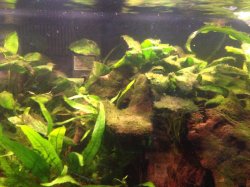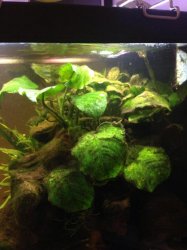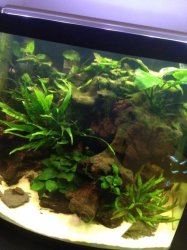Hi all
Just wondering if anyone can help me solve my algae problem!
I have a 90 litre nano cube, quite heavily planted with java fern and anubias. Its been set up since Christmas and I am still having algae problems. I do not use Co2 or fertilisers.
Its stocked with 7 cardinals, 4 corys, 3 killifish and 2 otocinclus.
Fish are fed once daily, tiny pinch of flake and pellets.
My parameters are (in PPM) -
PH 6.5
Ammonia 0
Nitrite 0
Nitrate between 0 and 5
In terms of the type of algae I believe it is green hair algae and some sort of brown algae. The otocinclus don't seem to be able to put a dent in it.
Oh and I water change 25% weekly
Does anyone have any advice or solutions to make it disappear?
Thanks in advance! Please excuse the poor iphone pictures - you get the idea!
Just wondering if anyone can help me solve my algae problem!
I have a 90 litre nano cube, quite heavily planted with java fern and anubias. Its been set up since Christmas and I am still having algae problems. I do not use Co2 or fertilisers.
Its stocked with 7 cardinals, 4 corys, 3 killifish and 2 otocinclus.
Fish are fed once daily, tiny pinch of flake and pellets.
My parameters are (in PPM) -
PH 6.5
Ammonia 0
Nitrite 0
Nitrate between 0 and 5
In terms of the type of algae I believe it is green hair algae and some sort of brown algae. The otocinclus don't seem to be able to put a dent in it.
Oh and I water change 25% weekly
Does anyone have any advice or solutions to make it disappear?
Thanks in advance! Please excuse the poor iphone pictures - you get the idea!





 /www.arcadia-aquatic.com/classica-stretch-led/
/www.arcadia-aquatic.com/classica-stretch-led/